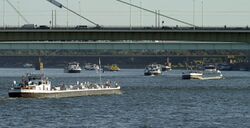Engineering:Inland navigation
Inland navigation, inland barge transport[1] or inland waterway transport (IWT)[2] is a transport system allowing ships and barges to use inland waterways (such as canals, rivers and lakes). These waterways have inland ports, marinas, quays, and wharfs.[3][4][5][6]
Environment
| Mode | eurocent per tonne-kilometre |
|---|---|
| Road (LCV) | 35.6
|
| Road (HGV) | 4.2
|
| Rail (diesel) | 1.8
|
| Rail (electric) | 1.1
|
| Inland vessel | 1.9
|
Modern researchers have long recognised that inland navigation is a relatively environmentally friendly option for freight transport compared to other modes of transportation such as air carriage and road transport, and similar to rail freight transport.[1][2][7] Therefore, policy makers have been aiming to shift the volume of cargo transported by more pollutive means towards inland navigation in order to reduce the overall environmental impact of transport, for example, as part of the European Green Deal (2019).[2] To accomplish this, however, various challenges need to be tackled, including making inland navigation itself less pollutive than it has been, building larger barges and tows to increase their efficiency, and constructing or improving inland waterways navigable enough for the projected volume and size of ships (deep and wide enough, with mega-locks for differences in elevation) to avoid bottlenecks.[1][7] The environmental effects of constructing, operating and maintaining inland navigation also need to be mitigated.[1]
See also
- Central Commission for Navigation on the Rhine
- Inland waterways of the United States
- Classification of European Inland Waterways
- Code Européen des Voies de la Navigation Intérieure (European Code for Interior Navigation)
- Grand Canal (China)
- Internal waters
- Navigability
External links
- Museum of Inland Navigation (Battaglia Terme, Padua)
References
- ↑ 1.0 1.1 1.2 1.3 Hunt, Constance Elizabeth (2013). Thirsty Planet: Strategies for Sustainable Water Management. London: Zed Books. pp. 154. ISBN 9781848137905. https://books.google.com/books?id=YRJjDgAAQBAJ&pg=PT154. Retrieved 29 March 2022.
- ↑ 2.0 2.1 2.2 2.3 Hofbauer, Florian; Putz, Lisa-Maria (2020). "External Costs in Inland Waterway Transport: An Analysis of External Cost Categories and Calculation Methods". Sustainability (MDPI) 12 (5874): 9 (Table 11). doi:10.3390/su12145874. https://www.mdpi.com/2071-1050/12/14/5874/pdf. Retrieved 29 March 2022.
- ↑ "About INE". Inland Navigation Europe. http://www.inlandnavigation.org/nl/about-ine_22.aspx.
- ↑ "USACE Planning Center of Expertise for Inland Navigation". US Army Corps of Engineers. http://inlandwaterways.lrh.usace.army.mil/.
- ↑ "Inland Rules of Navigation & Legal Definition". USlegal Inc.. http://definitions.uslegal.com/i/inland-rules-of-navigation/.
- ↑ "Inland Waterways". US Army Corps of Engineers. http://www.lrd.usace.army.mil/navigation/.
- ↑ 7.0 7.1 Pauli, Gernot (2015). "Chapter 14: Emissions and Inland Navigation". Green Transportation Logistics: The Quest for Win-Win Solutions. Cham, Switzerland: Springer. pp. 479. ISBN 9783319171753. https://books.google.com/books?id=EDswCgAAQBAJ&pg=PA479. Retrieved 29 March 2022.
 |


